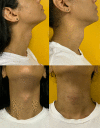Chondrolaryngoplasty in transgender women: Prospective analysis of voice and aesthetic satisfaction
- PMID: 37808531
- PMCID: PMC10553374
- DOI: 10.1080/26895269.2020.1848690
Chondrolaryngoplasty in transgender women: Prospective analysis of voice and aesthetic satisfaction
Abstract
Introduction: Chondrolaryngoplasty or "tracheal shaving" is cosmetic surgery to reduce the laryngeal prominence in transgender women. Complications may include damage to the vocal folds and epiglottic destabilization or aesthetic dissatisfaction. Objective: To assess and compare acoustic and perceptual voice outcomes and aesthetic satisfaction of transgender women submitted to chondrolaryngoplasty. Methods: Prospective interventional cohort of transgender women submitted to chondrolaryngoplasty between March 2018 and October 2019. Voice analysis included simple-blind application of the GRBAS Hirano scale by speech therapist and measurement of the fundamental frequency, in the preoperative and 1-month postoperative periods. The visual analog scale was used to analyze the aesthetic satisfaction, before and 6-months after chondrolaryngoplasty. Results: Fifteen patients participated, with a mean age of 31.7 ± 8.3 years (range 22-51 years). The mean postoperative follow-up period was 15.3 ± 6.1 months (range 6-25 months). There was a significant improvement in the visual analog scale for aesthetic satisfaction, with a preoperative mean = 0.7 ± 1.0 and a postoperative mean = 9.3 ± 1.1 (95% CI for difference = 7.3 to 9.6; p < 0.001). All patients presented a positive variation. The preoperative mean fundamental frequency was 171.3 ± 41.2 Hz and the postoperative, 177.1 ± 39.5 Hz, with no statistical significance (95% CI for difference = -30.1 to 41.7; p = 0.74). There was no statistically significant difference in the pre- and postoperative comparison of each component of the GRBAS scale. One (7%) patient presented a hyperpigmented scar and 2 (13%) reported hoarseness during the first postoperative week. There were no major complications such as disinsertion of the epiglottis or vocal folds. Conclusion: Chondrolaryngoplasty led to significant aesthetic satisfaction in transgender women. The surgery caused no noticeable vocal change in pitch or perception.
Keywords: Sex reassignment procedures; surgery; thyroid cartilage; transgender persons; voice.
© 2020 Taylor & Francis Group, LLC.
Conflict of interest statement
The authors declare that they have no conflict of interest.
Figures








References
-
- Coleman, E., Bockting, W., Botzer, M., Cohen-Kettenis, P., DeCuypere, G., Feldman, J., Fraser, L., Green, J., Knudson, G., Meyer, W. J., Monstrey, S., Adler, R. K., Brown, G. R., Devor, A. H., Ehrbar, R., Ettner, R., Eyler, E., Garofalo, R., Karasic, D. H., … Zucker, K. (2012). Standards of care for the health of transsexual, transgender, and gender-nonconforming people, version 7. International Journal of Transgenderism, 13(4), 165–232. 10.1080/15532739.2011.700873 - DOI
-
- Enver, N., Doruk, C., Kara, E., Kasali, K., Asliyuksek, H., & Basaran, B. (in press). Does size matter in laryngology? Relation between body height and laryngeal morphometry. Journal of Voice. - PubMed
-
- González, J., Cervera, T., & Miralles, J. L. (2002). Análisis acústico de la voz: Fiabilidad de um conjunto de parâmetros multidimensionales [Acoustic voice analysis: Reliability of a set of multi-dimensional parameters]. Acta Otorrinolaringológica Española, 53(4), 256–268. 10.1016/S0001-6519(02)78309-X - DOI - PubMed
LinkOut - more resources
Full Text Sources
